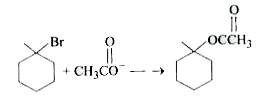Which of the following reactions will not be affected by increasing the pressure?
PCl5(g)⇔PCl3(g)+Cl2(g)
N2(g)+O2(g)⇔2NO(g)
CaCO3(s)⇔CaO(s)+CO2(g)
CO(g)+H2O(g)⇔CO2(g)+H2(g)
The correct Answer is:B, D
To determine which reaction will not be affected by an increase in pressure, we need to apply Le Chatelier's principle. This principle states that if an external change is applied to a system at equilibrium, the system will adjust to counteract that change and restore a new equilibrium.
1. Understand the Effect of Pressure on Equilibrium:
- According to Le Chatelier's principle, increasing the pressure in a gaseous reaction will shift the equilibrium towards the side with fewer moles of gas. This is because a higher pressure favors the formation of products or reactants that occupy less volume.
2. Calculate the Change in Moles of Gas (Δng):
- For each reaction, we need to identify the number of moles of gaseous reactants and products. The change in moles of gas (Δng) is calculated as:
Δng=(moles of gaseous products)−(moles of gaseous reactants)
- If Δng = 0, it means that the number of moles of gas is the same on both sides of the reaction, and thus the reaction will not be affected by changes in pressure.
3. Analyze Each Reaction:
- Option 1:
- Reactants: 1 mole gas
- Products: 1 mole gas
- Δng = 1 - 1 = 0 (This reaction is not affected by pressure.)
- Option 2:
- Reactants: 1 mole gas
- Products: 2 moles gas
- Δng = 2 - 1 = 1 (This reaction is affected by pressure.)
- Option 3:
- Reactants: 1 mole gas
- Products: 1 mole gas
- Δng = 1 - 1 = 0 (This reaction is not affected by pressure.)
- Option 4:
- Reactants: 2 moles gas
- Products: 2 moles gas
- Δng = 2 - 2 = 0 (This reaction is not affected by pressure.)
4. Conclusion:
- The reactions that will not be affected by increasing the pressure are those where Δng = 0. From the analysis:
- Option 1, Option 3, and Option 4 have Δng = 0.
- Option 2 has Δng ≠ 0 and will be affected by pressure.
Final Answer:
The reactions that will not be affected by increasing the pressure are Option 1, Option 3, and Option 4.
- According to Le Chatelier's principle, increasing the pressure in a gaseous reaction will shift the equilibrium towards the side with fewer moles of gas. This is because a higher pressure favors the formation of products or reactants that occupy less volume.
- For each reaction, we need to identify the number of moles of gaseous reactants and products. The change in moles of gas (Δng) is calculated as:
Δng=(moles of gaseous products)−(moles of gaseous reactants)
- If Δng = 0, it means that the number of moles of gas is the same on both sides of the reaction, and thus the reaction will not be affected by changes in pressure.
- Option 1:
- Reactants: 1 mole gas
- Products: 1 mole gas
- Δng = 1 - 1 = 0 (This reaction is not affected by pressure.)
- Option 2:
- Reactants: 1 mole gas
- Products: 2 moles gas
- Δng = 2 - 1 = 1 (This reaction is affected by pressure.)
- Option 3:
- Reactants: 1 mole gas
- Products: 1 mole gas
- Δng = 1 - 1 = 0 (This reaction is not affected by pressure.)
- Option 4:
- Reactants: 2 moles gas
- Products: 2 moles gas
- Δng = 2 - 2 = 0 (This reaction is not affected by pressure.)
- The reactions that will not be affected by increasing the pressure are those where Δng = 0. From the analysis:
- Option 1, Option 3, and Option 4 have Δng = 0.
- Option 2 has Δng ≠ 0 and will be affected by pressure.
The reactions that will not be affected by increasing the pressure are Option 1, Option 3, and Option 4.
Topper's Solved these Questions
- CHEMICAL EQUILIBRIUMBOOK - CENGAGE CHEMISTRY ENGLISHCHAPTER - CHEMICAL EQUILIBRIUMEXERCISE - Exercises (Assertion-Reasoning)
15 Videos
- CHEMICAL EQUILIBRIUMBOOK - CENGAGE CHEMISTRY ENGLISHCHAPTER - CHEMICAL EQUILIBRIUMEXERCISE - Exercises (Integer)
7 Videos
- CHEMICAL EQUILIBRIUMBOOK - CENGAGE CHEMISTRY ENGLISHCHAPTER - CHEMICAL EQUILIBRIUMEXERCISE - Exercises (Multiple Correct)
26 Videos
- CHEMICAL BONDING AND MOLECULAR STRUCTUREBOOK - CENGAGE CHEMISTRY ENGLISHCHAPTER - CHEMICAL BONDING AND MOLECULAR STRUCTUREEXERCISE - Archives Subjective
15 Videos
- CLASSIFICATION AND NOMENCLATURE OF ORGANIC COMPOUNDSBOOK - CENGAGE CHEMISTRY ENGLISHCHAPTER - CLASSIFICATION AND NOMENCLATURE OF ORGANIC COMPOUNDSEXERCISE - Analytical and Descriptive Type
3 Videos
Similar Questions
Knowledge Check
Which of the following reaction will not affected on increasing the pressure ?
A2H2(g)+CO(g)⇔CH3OH(g)B4NH3(g)+5O2(g)⇔4NO(g)+6H2O(g)CCH4(g)+2S2(g)⇔CS2(g)+2H2S(s)DPCl5(g)⇔PCl3(g)+Cl2(g)Which of the following reactions will go faster if the concentration of the nucleophile is increased ?
A B
B C
C DNo comparison between these reactions
DNo comparison between these reactionsWhich one of the following will not directly affect transpiration?
ALightBTemperatureCWind speedDChlorophyll content of leaves
Which of the following process will be affected by the absence of enterokinase ?
View SolutionWhich of the following reactions proceed at low pressure?
View SolutionWhich among the following reactions will be favoured at low pressure?
View SolutionWhich one of the following will not directly affect transpiration?
View SolutionWhich of the following does not affect light phase
View Solution
